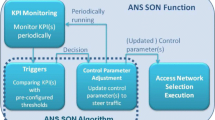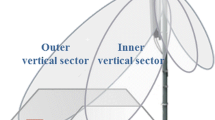Abstract
In wireless communications the demand for wide range of services is leading to a rapid increase in network performance requirements. Hence, today’s cellular radio technologies are designed to operate closer to Shannon capacity bound which sets the ultimate upper limit for the wireless channel capacity. Yet, good link level performance does not necessarily mean that network resources are used efficiently as the cellular capacity and coverage performance may not be optimal resulting from dynamic conditions in radio network environment such as urbanization, insertion or deletion of base stations, and malfunctioning nodes. Due to the fact that reacting on those inherent problems manually is very expensive and time consuming, automated optimization of cellular coverage and capacity by means of self-optimization of adaptive antenna system parameters could be an attractive solution from the network operator’s point of view. Furthermore, suboptimal antenna parameter selection in long term evolution (LTE) network planning or the reuse of the sites and antenna parameters of a preceding access technology requires optimization of adaptive antenna system parameters. In this article we propose a novel centralized self-optimization approach that can be used for adapting antenna system parameters in order to automatically control network capacity and coverage in a macro-cellular deployment. In the proposed approach we present case-based reasoning (CBR) based self-optimization aided by an exemplary rule-based scheme which is required during the training phase of CBR. Dynamic system level downlink simulator is developed to validate the performance of the proposed approach in a realistic macro-cellular scenario. In performance evaluations the 3rd generation partnership project LTE system framework is assumed and propagation is modeled in three dimensions.
















Similar content being viewed by others
References
3GPP. Overview of 3GPP LTE. Available: http://www.3gpp.org/LTE.
Next generation mobile networks. Use cases related to self organising network, overall description, Version 2.02, April 2007. Available: http://www.ngmn.org
3GPP, TR 36.902 V9.3.0. Self-configuring and self-optimizing network use cases and solutions. Available: http://www.3gpp.org
Yilmaz, O. N. C., Hämäläinen, S. & Hämäläinen, J. (2009) . Analysis of antenna parameter optimization space for 3GPP LTE. In Proceedings of IEEE Vehicular Technology Conference (VTC Autumn), Anchorage-Alaska, USA.
Yilmaz, O. N. C., Hämäläinen, S. & Hämäläinen, J. (2009). Comparison of remote electrical and mechanical antenna downtilt performance for 3GPP LTE. In Proceedings of IEEE Vehicular Technology Conference (VTC Autumn), Anchorage-Alaska, USA.
Athley, F. & Johansson, M. N. (2010). Impact of electrical and mechanical antenna tilt on LTE downlink system performance. In Proceedings of IEEE Vehicular Technology Conference (VTC Spring), Taipei, Taiwan.
Pettersen, M., Bråten, L. E. & Spilling, A. G. (2004). Automatic antenna tilt control for capacity enhancement in UMTS FDD. In Proceedings of IEEE Vehicular Technology Conference (VTC Fall), Los Angeles, USA.
Turke, U. & Koonert, M. (2005). Advanced site configuration techniques for automatic UMTS radio network design. In IEEE Vehicular Technology Conference (VTC Spring), Stockholm, Sweden.
Siomina, I., Värbrand, P., & Yuan D. (2006). Automated optimization of service coverage and base station antenna configuration in UMTS networks. IEEE Wireless Communications 13(6), 16–25
ul Islam, M. N., Abou-Jaoude, R., Hartmann, C. & Mitschele-Thiel, A. (2010). Self-optimization of antenna tilt and pilot power for dedicated channels. In Modeling and Optimization in Mobile, Ad Hoc and Wireless Networks (WiOpt), Avignon, France.
Siomina, I. & Yuan, D. (2008). Enhancing HSDPA performance via automated and large-scale optimization of radio base station antenna configuration. In IEEE Vehicular Technology Conference (VTC Spring), Marina Bay, Singapore.
Razavi, R., Klein, S., & Claussen, H. (2010). A fuzzy reinforcement learning approach for self-optimization of coverage in LTE networks. Bell Labs Technical Journal 15(3), 153–175
Eckhardt, H., Klein, S. & Gruber, M. (2011). Vertical antenna tilt optimization for LTE base stations. In Proceedings of IEEE Vehicular Technology Conference (VTC Spring), Budapest, Hungary.
Wang, Y., Yang, X., Ma, A. & Cuthbert, L. (2009). Intelligent resource optimisation using semi-smart antennas in LTE OFDMA systems. In Proceedings of IEEE International Conference on Communications Technology and Applications (ICCTA), Beijing, China.
ul Islam, M. N. & Mitschele-Thiel, A. (2012). Reinforcement learning strategies for self-organized coverage and capacity optimization. In IEEE Wireless Communications and Networking Conference (WCNC), Paris, France.
Awada, A., Wegmann, B., Viering, I. & Klein, A. (2011). Optimizing the radio network parameters of the Long Term Evolution system using Taguchi’s method. IEEE Transactions on Vehicular Technology 60(8), 3825–3839
Blume, O., Eckhardt, H., Klein, S., Kuehn, E., & Wajda, W. M. (2010). Energy savings in mobile networks based on adaptation to traffic statistics. Bell Labs Technical Journal 15(2), 77–94
Dottling, M., & Viering, I. (2009). Challenges in mobile network operation: Towards self-optimizing networks. In Proceedings of IEEE International Conference on Acoustics, Speech and Signal Processing, Taipei, Taiwan.
Donelli, M., Caorsi, S., De Natale, F. G. B., Franceschini, D., Massa, A. (2004). A versatile enhanced genetic algorithm for planar array design. Journal of Electromagnetic Waves and Applications 18(11), 1533–1548
Massa, A., Donelli, M., De Natale, F. G. B., Caorsi, S., & Lommi, A. (2004). Planar antenna array control with genetic algorithms and adaptive array theory. IEEE Transactions on Antennas and Propagation 52(11), 2919–2924
Lobinger, A., Stefanski, S., Jansen, T. & Balan, I. (2010). Load balancing in downlink LTE self-optimizing networks. In Proceedings of IEEE Vehicular Technology Conference (VTC Spring), Taipei, Taiwan.
Yilmaz, O. N. C., Hämäläinen, S. & Hämäläinen, J. (2010). Self-optimization of remote electrical tilt. In Proceedings of IEEE Personal, Indoor and Mobile Radio Conference (PIMRC), Istanbul, Turkey.
Yilmaz, O. N. C. (2011) Demonstration of a dynamic system level LTE network simulator. Available: http://www.youtube.com/watch?v=1kUalA2Y5L4
Yilmaz, O. N. C., Hamalainen, S. & Hamalainen, J. (2009). System level analysis of vertical sectorization for 3GPP LTE. In International Symposium on Wireless Communication Systems (ISWCS), Siena, Italy.
Awada, A., Wegmann, B., Rose, D., Viering, I. & Klein, A. (2011). Towards self-organizing mobility robustness optimization in inter-RAT scenario. In Proceedings of IEEE Vehicular Technology Conference (VTC Spring), Budapest, Hungary.
Yilmaz, O. N. C., Hämäläinen, J. & Hämäläinen, S. (2011). Self-optimization of random access channel in 3rd Generation Partnership Project Long Term Evolution. Wireless Communications Mobile Computing 11(12), 1507–1517
3GPP, TR 36.814 V9.0.0. Evolved Universal Terrestrial Radio Access (E-UTRA); Further advancements for E-UTRA physical layer aspects. Available: http://www.3gpp.org
Laiho, J., Wacker, A., & Novasad, T. (2006). Static radio network simulator. Radio Network Planning and Optimization for UMTS (2nd Edition). NewYork:John Wiley & Sons Inc.
Danneberg, M., Holfeld, J., Grieger, M., Amro, M., & Fettweis, G. (2012). Field trial evaluation of UE specific antenna downtilt in an LTE downlink. In International ITG Workshop on Smart Antennas (WSA), Dresden, Germany.
Zheng, Y. R., & Xiao, C. (2002). Improved models for the generation of multiple uncorrelated Rayleigh fading waveforms. IEEE Communications Letters 6(6), 256–258
Mogensen, P., Na, W., Kovcs, I. Z., Frederiksen, F., Pokhariyal, A., Pedersen, K. I., Kolding, T., Hugl, K., & Kuusela, M. (2007). LTE capacity compared to the Shannon bound. In Proceedings of IEEE Vehicular Technology Conference (VTC Spring), Dublin, Ireland.
3GPP, TR 36.942 V9.1.0. Evolved Universal Terrestrial Radio Access (E-UTRA); Radio Frequency (RF) system scenarios. Available: http://www.3gpp.org
3GPP, TS 36.133 V9.6.0. Evolved Universal Terrestrial Radio Access (E-UTRA); Requirements for support of radio resource management. Available: http://www.3gpp.org
3GPP TS 36.331 V9.5.0. Evolved Universal Terrestrial Radio Access (E-UTRA); Radio Resource Control (RRC); Protocol specification. Available: http://www.3gpp.org
3GPP, TS 36.300 V.9.6.0. Evolved Universal Terrestrial Radio Access (E-UTRA) and Evolved Universal Terrestrial Radio Access Network (E-UTRAN); Overall Description, Stage 2. Available: http://www.3gpp.org
Uehara, K. (1998). Random case analysis of inductive learning algorithms. In Proceedings of the First International Conference on Discovery Science.
Aha, D. W. (1991). Case-based learning algorithms. In Proceedings of Case-Based Reasoning Workshop, pp. 147–158.
Langley, P. & Iba, W. (1993). Average-case analysis of a nearest neighbor algorithm. In Proceedings of the 13th IJCAI, pp. 889–894
Alpaydin E. (2010) Introduction to machine learning (2nd Edition, pp. 486–489). Cambridge, MA:The MIT Press.
Hamalainen, S. O., Yilmaz, O. N. C., Tang, H. & Wacker, A. F. (2011). Method of improving coverage and optimisation in communication networks, U.S. Patent Application No. 13/127,771, Publication No. 20110212720, April 1, 2011.
Author information
Authors and Affiliations
Corresponding author
Rights and permissions
About this article
Cite this article
Yilmaz, O.N.C., Hämäläinen, J. & Hämäläinen, S. Optimization of adaptive antenna system parameters in self-organizing LTE networks. Wireless Netw 19, 1251–1267 (2013). https://doi.org/10.1007/s11276-012-0531-3
Published:
Issue Date:
DOI: https://doi.org/10.1007/s11276-012-0531-3




